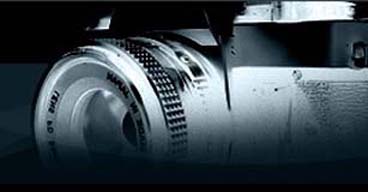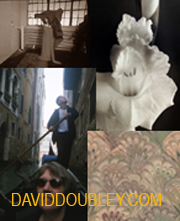Greece - Day Fourteen, October 14th
Today I booked an all day trip from Athens to the Delphi, the ancient city where the ancient Greeks went to get to pray to Apollo and consult the Oracle of the Delphi. The Temple of Apollo was nestled in the hills near Mt. Parnassus. One of the memorable Oracles was a woman name Pythia. She was said to prognosticate the future in a voice that only the priests could interpret. Delphi was known throughout the ancient world. The ancient temple has been destroyed and rebuilt many times in this earthquake prone area. The Delphi Museum houses the archaeological artifacts that have been recovered there.
The events of the day did not do my swollen ankle and leg any good. I was feverish and in quite a bit of discomfort. This evening I called my medical insurance and they put me in contact with a nurse who warned me to see a doctor as soon as possible as the swelling may be caused by a blood clot. If this where the case I was at risk of having a stroke or heart attack. When I returned from the tour I took a cab to the nearest hospital emergency room. The events of the long evening were quite an experience as almost no one spoke English in the hospital. I resorted to drawing pictures to explain my ailment. After wandering all over the hospital, I randomly ran into a doctor who spoke English. He prescribed a ultrasound for my leg. I was sent to the hospital administration office to pay for the procedure but clerical ladies did not speak English there either. Through gesturing I was able to explain that I did not have enough greek money. Unbeleivabley, they would not take American dollars or even my credit card!! In desperation and kindness, they approved my procedure without payment and I was able to go back to hospital area to get the ultrasound. The crowded hospital was dirty, old and dilapidated but they did have ultrasound equipment.. After a few hours the results indicated no blood clots!! They recommend I see general practitioner, but I decided to tough it out until I got home. Luckily, I will flying home tomorrow, the evening of October 15th. I often travel alone, but this episode made me re-evalute that practice.
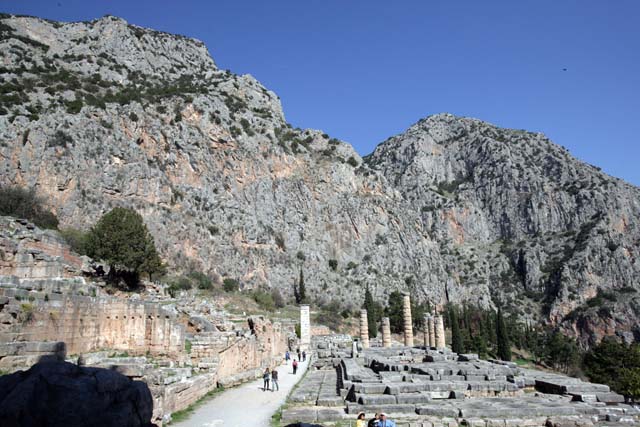
Site of the Temple of Apollo
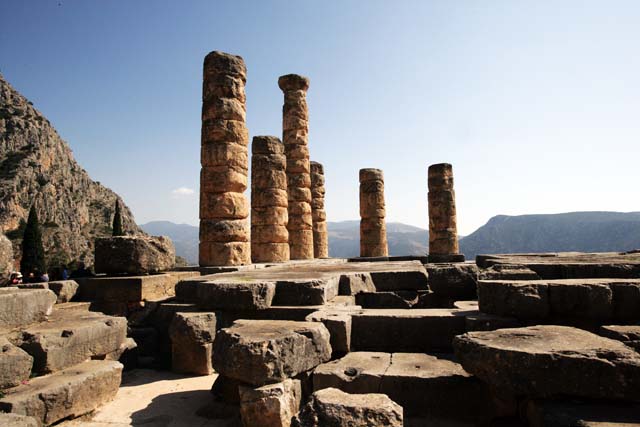
Some assembled columns at the Temple of Apollo Site
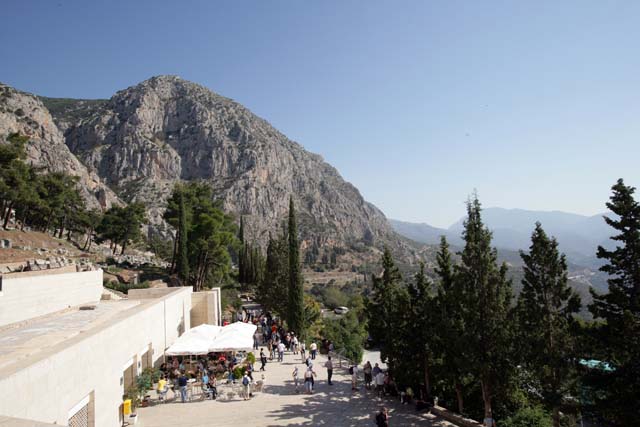
The Delphi Museum with Mt. Parnassus View
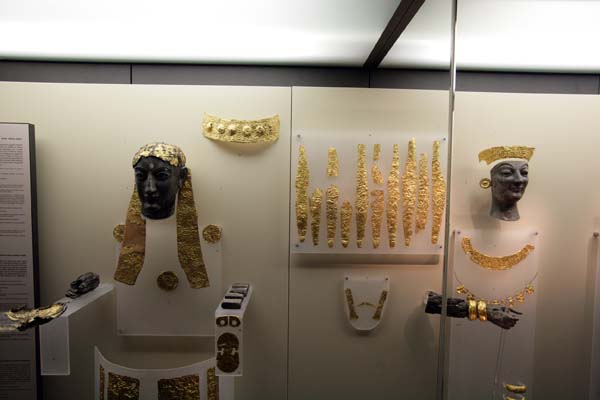
Some of the Arifacts Found On Site.

Greece - Day Thirteen, October 13th
Today I am forging ahead, though my ankle, lower leg, foot are still swollen. My tour bus arrived and we began our tour of the city. Though Anthens is an old city, many of its buildings reflect the many conquerors it has endured. The ancients ruins here are in pretty bad shape consequently. We toured the Panathenian Stadium, site of the first modern Olympic games. We saw the Greek parliament building and some other quick tours. We finished at the base of the Acropolis, dismounted, about a half mile from the Parthenon and began a fast paced treacherous trek up the mountain to the Parthenon temple. Our guide walked very fast, and I fell behind the large group of 30 persons several times. She took a break, and told us to find our way back to the bus anytime we wanted. The museum site was very crowded and I really could not get any good photographs. I ended up leaving before the group returned en mass to the bus. I got lost on way back and couldn't find our bus. I then decided to take one of the cabs that hung around the base of the mountain. The cab driver turned out to be a crook, charging me close to a hundred dollars when we reached the hotel. It was the worst experience I've had travelling. I think some of this was due to my ankle problems and a fever I had developed.
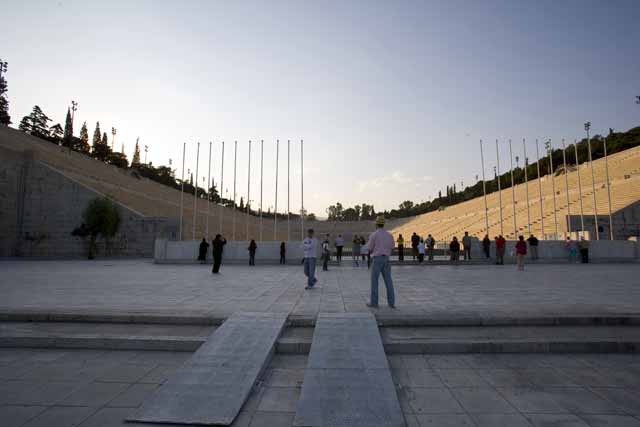
Modern Olympic Stadium, site of the first Modern Olympics in Athens
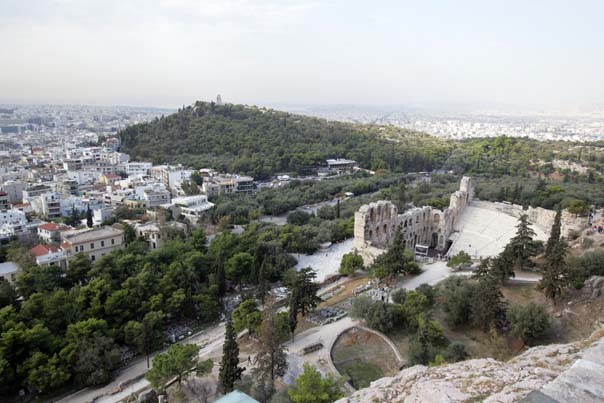
Ancient Greek Theatre/Stadium in Athens
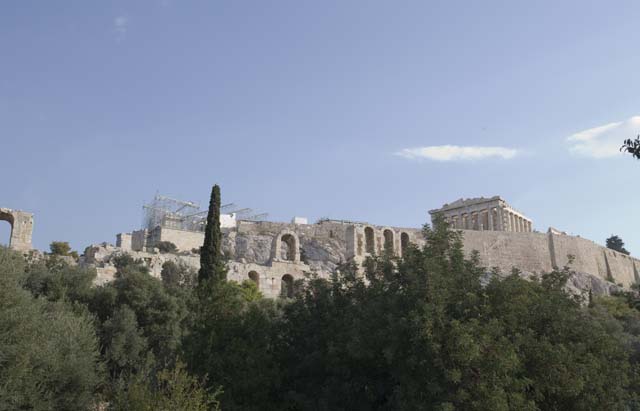
Scenic shot of the Acropolis and the Parthenon Temple from a nearby road
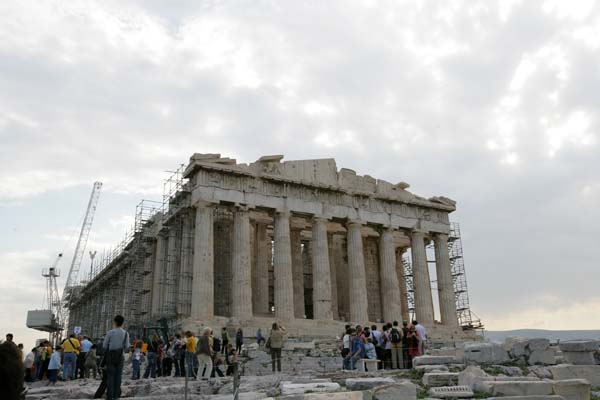
The Parthenon Temple

Frontal View of the Parthenon Temple.
Video of the Parthenon Site
Greece - Day Twelve, October 12th
Today I travel to Athens, Greece. I will be on my own and without a travel group throughout my stay in Greece. For some reason my right ankle and leg began to swell quite badly. So much so, that I had trouble walking. I made it ,however, to my hotel, and I rested a bit. I didn't feel like taken photos today. I plan to have this ankle swelling checked out but for now I'll manage. Tomorrow I have scheduled a tour of Athens and then a trip to the Athenian Acropolis see the Parthenon temple..
Turkey - Day Eleven, October 11th
Today is a travel day. We will be traveling from Cappadocia to the capital of Turkey, Ankara. The travel time is more than 8 hours.
We stopped to take a final look at the landscape around Cappadocia on a brief stop before heading to again to Ankara.
We were also taken for a visit to a local potter's shop for the obligatory demonstration and sales pitch. This pottery shop is in a cave, and the family has been in business since the time of the Ottoman Empire. All of their pottery is handmade in very intricate fashion. They make pottery out of the local red clay and a white version that uses quartz for superior hardness.
Before getting to our hotel we will stop and take look at the Ataturk memorial. Ataturk is memorialized everywhere, though he died in 1938. For the Turkish people he is the father of modern Turkey. He took a country run by the old Ottoman empire with its Sultans and Califs and dragged his country into the 20th century by deciding to follow the European model. The changes could not have been more drastic. He abolished a 1000 year old culture, switched the writing from Persian script to alphabet, made his government secular and removed the Islamic religious controlled government and replaced it with elected leadership. His face is everywhere, even 40 years after his death. Criticism of him literally a crime here.
A Panoramic View of the Potter's Shop
Turkey - Day Ten, October 10th
Today we did a number of things. Early this morning I took a balloon ride near Cappadocia. Cappadocia is known all over the world for its fantastic ballooning views. The balloon itself was huge, capable of taking 20 people aloft. As you’ll see from the photos, the Cappadocia landscape with caves that seem like something out of the Star Wars movie.
Next we went to the Goreme Valley. It is an unusual area of volcanic landscapes and rock hewn churches. The people of this area lived in the natural caves. They enlarged them, shaped them for livability and built connecting tunnels. This provided safety from invading armies. Many Christians lived in this area since it provided protection from persecution. Many small churches were built in the caves in this area. Many still contain the Byzantine and Roman fresco painting. Unfortunately many of the surviving paintings had the eyes scratched out or were plastered over when this area was taken over by Islamic conquering armies, who found the images of people offensive to their religion. I found this to be true with Christians also when they re-habilitated ancient Egyptian structures for their churches.
We then traveled to place in area called the Zelve Valley. The geological landscape similarly had homes built throughout rock formations. Of note was a cave that was said to housed the apostle Simon. Many of the ancient caves are still being used.
Our final destination was to visit a restaurant built in an underground cave for an evening show. We saw a number of folk dances from this area, but the highlight of the evening was the belly dancing.
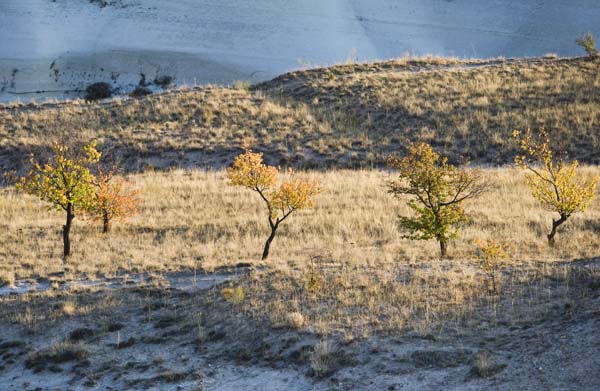
A Balloon Ride of Coppadocia
Belly Dancer in Goreme
Belly Dancing Troupe in Goreme
Traditional Turkish Folk Dancers
Turkey - Day Nine, October 9th
Today we will be traveling for 12 hour by bus to the city of CAPPADOCIA. We will stop in the city of Konya along the way to see the museum and monument to the Whirling Dervishes. The museum is called Mevalan Tekke after one of the founders of the Islamic sect. The sect itself is banned in Turkey, but it survives under a founding group to preserve the history of this strange sect. The act of whirling enables the dervishes to reach up to god through an act of movement which brings symbolic death, the final and only way to transcend levels of ascension required to reach Allah and become one with god and reach “perfect love”.
At night we went to a Whirling Dervish ceremony but could not take photographs during the ritual. It consisted of six dancers, about four musicians, and a master dervish. The dervishes were robed in black, symbolizing life, under which they wore the skirt-like costume which was all white; symbolizing death. They all wore 12” felt fezzes representing a tombstone. The dancers began seated on lambskin mats, then removed their black robes, rose and began a slow circular march around the room. At one point each dancer began to spin and while reaching their hands upward toward heaven. This lasted for about 20 minutes and they, with head tilted about 20 degrees, reached a state of ecstasy. At this point I supposed they start to reach the dream state needed to seek nirvana. I was not allowed to photograph the ceremony but I found a video taken at the same place I think I attended. SEE THIS VIDEO ON YOUTUBE.
We also stopped at a location; I don’t have the name, which was a sort of fort for camel caravans in the town. This allowed them relative safety on for their travels.
As we approach Cappadocia, we see in the distance through bus window, a smoldering volcano. The volcano is called Mt. Hasan. Cappadocia is surrounded by 3 volcanos. We are told that they are dormant and the locals have nothing to fear is the near future. The ancient eruptions have made this area a prime agricultural area.
Click on image see a You-Tube Video of the Dirvish Dance.
Traveling On the Bus to Cappadocia
Turkey - Day Eight, October 8th
Today we visited two places. The first was a leather clothing manufacturer near the town of Pamukkale. Strangely, this trip was not included in our published itinerary. It is not uncommon for guided tours, such as this one, to take tourists for factory tours where they are entertained or given little courses on their product . Usually, afterwards introducing the “new” clients to their showroom, where they get to purchase what ever they’ve seen at discounted prices. For me such an excursion is a waste of time for which I paid. For the shopping crowd, this is another opportunity for shopping. I’ve concluded that in a broad since this helps the economy of this country, but it’s painfully exploitative to me. The leather company will go unnamed.
Next, at Pamukkale, we saw the geological formation called the “Cotton Castle”. It is a white marble like promontory of calcium, calcium carbonate, and other minerals from the thermal springs that this area has been famous for, even in antiquity. The ancient ruins of Hierapolis are here and are testimony to the belief in the curative powers of the warm waters emanating from the earth. The site is very large, easily a mile from end to end. The ancients came here seeking cures and to die here. There is a very large necropolis containing tombs and crypts for the wealthy dead of ancient. The apostle Phillip was said to have come to this area. Today, the waters are still being used. People come with their bathing suits to bathe in the water or just dip their feet in the warm rushing water.
Models showing off Leather fashions to a captive audience.
The "Cotton Castle" Calcium covered rock formation in Pamukkale
Bathers in the warm waters from the underground springs
View from atop the "Cotton Castle"
A court yard in Pamukkale
Turkey - Day Seven, October 7th
Today we traveled to see the two locations. The first stop today was the site of the ancient Roman city of Ephesus. This was a fable port city on the Aegean Sea which boasted a large Greek Coliseum that was converted into a full Roman coliseum. The coliseum hosted everything from theatre to violent combat. Many Christians escaped persecution in this Roman city. Several of the Christian apostles lived in the area, including the man called St. John. The city is only now being excavated and has many years until the full extent of this excavating will be known.
Later we visited the town of Ephesus and the local museum. It has samples of artifacts that have been discovered there.
Finally we visited the site that is reputed to be home of Mary, the mother of Jesus, who is revered by both Christians and Moslems. As it is written in the bible. Christ before he died asked John to help take of Mary. Since it is well documented that John was known to have lived in Ephesus it is Mary would be near him.
Finally, we drove to our next town called Kusadasi and stay at the Charisma Hotel. The hotel is a very beautiful building built on the coastline of the Aegean sea.
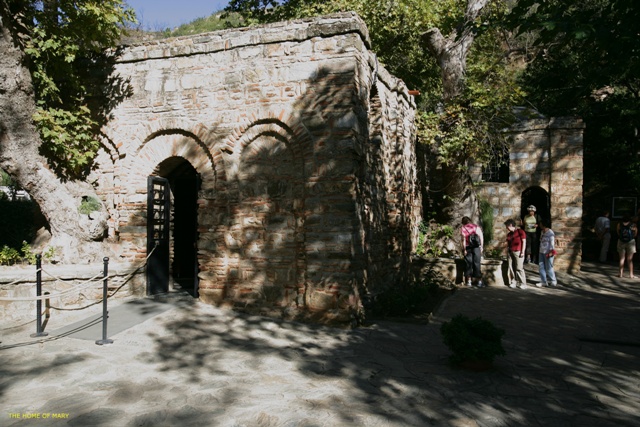
Catholic Shrine believed to be the home of Mary after Christ's death
Video View of the Ruins of Ancient Ephesus
Today we visited several ancient sites. First we visited a location that is supposed to be the location of the ancient Troy we know from the Greek tale by Homer. Many scholars have doubted that Troy ever existed. The site has a rather “campy” looking wooden horse erected at the entrance that reminds us of ancient tale. This ancient habitation site was uncovered by a 19th century treasure hunter/archeologist named Heinrich Schliemann, who did as much to damage the site as he did good, in his quest for ancient treasure. He did find ancient “treasure” which he called “King Priam’s Treasure” after the king described in Homer’s Iliad. The style of the jewelry, scholars say now, is not Greek. Overall he uncovered the remains of 9 ancient cities each built on top of the other and some that existed before ancient Troy.
We then traveled to Pergamon, once an ancient Greek kingdom built by one of the generals of Alexander the Great. There is an Acropolis there that was said to have housed 200,000 volumes. This place is on a high mountain that protected it against attack. In the area is also an ancient therapeutic center , called the ruins of Asklepion, which housed ancient baths and treatment areas. There are ancient tunnels, and pillar lined walkways throughout the site which were utilized to obtain cures for ailments. Like the Acropolis there are stone amphitheaters at the site.
We finished the long day by traveling Izmir for the night on the shores of the Aegean Sea. The city is a sprawling modern city and is Turkey’s third largest city. See the photos below.
Video of Asklepion - A Fellow Traveler Sings in Background
Turkey - Day Five, October 5th
Today we left Istanbul and headed around the Sea of Marmara to the peninsula known as the Gallipoli Peninsula. It was a long 5 hour bus ride to get there. Unless you are a history buff, you might not know that this is a famous battle ground. In 1915 Great Britain and its allies attempted to take this territory away from the weakening Ottoman Empire (Turkey) so they could control the waterways into the Black Sea for themselves. Unfortunately, they miscalculated the will of the Turkish armies to defend their homeland. The loss of life was appalling on both sides. The allies had about 44,000 dead and 97,000 wounded. This included about 10,000 dead and 25,000 wounded Australians and New Zealanders. The Ottomans (Turkey) lost 56,000 dead and 140,000 wounded. Not only did Turkey win this battle it also lead to its formation as a democracy and hastened the demise of the Ottoman rulers.
About 25 out of 40 of my fellow tourists are from New Zealand and Australia. They were moved by the battle site, called Anzac, where most of their countrymen died. We visited both the Lone Pine Memorial Cemetery for the British allies and the Turkish memorial cemetery.
We spent a few hours looking at some of the original foxholes and trenches where combatants were as close as 24 feet from each other. The British had respect for the Turks, who fought without poison gas, and were seen as more honorable as soldiers. Before the war Turks were called barbarians by the British.
After that we were taken to the little port city of Eceabat to the car ferry which took us to our hotel in Canakkale, Turkey. This will be our next tour location.
The hotel here in Canakkale , is called the Kolin Hotel. It is very modern and up to date. Unlike the Crowne Plaza it is away from the city. The population is only about 100,000 compare to 17 million in Istanbul. Best of all, this hotel has air conditioning! It has tennis courts, an outdoor and indoor swimming pool, Turkish baths, masseuses, tennis courts, exercise rooms, even a soccer field. There is even a modern shopping mall across the road, so finally I can be a bottle of water for 50 cents instead of $4. The cans of Coca Cola were only $1; I paid as much as 4X that in Instanbul.
Turkey - Day Four, October 4th
Today is the official start of my tour group. We have 38 people, mostly middle to late middle aged couples. They are mostly Australians and Canadians. We begin our tour by going to Topaki Palace, for the Caliph of the Ottoman Empire and his many, many, wives and concubines. We go inside the Hagia Sophia Church/Mosque, which is really has been relegated to a Museum. Finally, we go inside the Blue Mosque; whose more formal name is the Sultan Ahmet Mosque.
In the Topack Palace we saw jewels and gold implements of amazing artistry and size. There was a diamond the size of plum. They had emeralds’ nearly as large as the diamond. There were diamond incrusted cups, knives, furniture, and even a gold baby crib. Also this is the home of Islamic relics removed from Egypt after the Ottoman ruler captured Egypt and named himself Caliph, head of all Islam. They had the banner flag of Mohammed, his foot print, bones from the arm of great Islamic warriors. To the non-religious this seems strange until you consider the Catholic church did the same. Such things re-enforced that the commitment of the faithful. Unfortunately, I was not allowed to photograph any of it.
The Hagia Sophia as I mentioned was built by Christians in the 6th century. The church was built by the Roman empire after the death of Christ and lasted well in the middle ages. At that time the church was correctly called the Eastern Roman Empire or Byzantine Empire. They are more aligned with the Orhodox churches like the Russian Orthodox Church, or Greek Orthodox. They filled their churches with painting of holy images the had a very flat, cartoon-like image. We call this art “Byzantine Art”. This art lasted through the fall of the Roman Empire and into the Ottoman Empire which lasted from the 1300’s until the very early 1900’s. It was most powerful during the 1600 and 1700’s. Hagia Sophia has amazing examples of Byzantine art.
We finished the tour by spending and hour in Grand Bazaar. It’s a maze of small streets containing more than 4000 small shops
This is the last day in Instanbul, tomorrow is a long travel day. I hope I have time to photograph. See the images below.
Video View Inside Hagia Sophia Cathedral
Video View Inside the Blue Mosque
Turkey - Day Three, October 3rd
Today I decided to make a easy day of it and take a break from seeing touristy things. I decided to walk outside the hotel and get some lunch, Turkish style.
I walked a while and finally stopped at one of the countless street side restaurants. These places are where the locals go to eat. The place I stopped at is called a kebab house, ocakbasi in Turkish. They usually serve hot meat and vegetable dishes with rice. In the photo you will see roast chicken (which I had) and roasted meat which is stacked on a huge upside down cone shaped skewer. The meat, beef or chicken, is sliced off in little pieces for what is called a doner kebab. The doner is a pita-like bread pocket filled with meat and vegetables.
I decided to take a closer look at the mosque outside my hotel window. It’s just a small, ordinary mosque called the Valide Sultan Camii. I think the word "camii" means mosque. It sits above street level , on a hill. Historically, it was one of the last mosques built in the Ottoman Era,
The noise on Turgut Ozal Boulevard, adjacent next to the hotel, can be deafening. This street has the electric train which takes people back and forth to the Old Town area. There are roads on either side of it, carrying countless cars and buses. If you exit off this street, walk up the old cobbled stone stairs to the Valide Sultan Mosque, everything gets quiet and peaceful. It’s amazing. As I walked around the court yard I watched worshipers come in, go to the granite podium, remove their shoes, wash their face, hands and feet, and proceed to the carpeted prayer areas to do their prayers. The prayer area is off limits for cameras, uncovered arms, shorts, miniskirts, and of course shows.
Through another doorway, I stumbled upon an old bazaar, which housed a traditional Turkish coffee house. There were no women of course, just men drinking coffee, old smoking bubble pipes, and I am sure, a few games of backgammon. See the photos below.
The Public Trains Instanbul Near the Hotel
View Inside a Mosque Across from My Hotel
Today is my second night at the Crowne Plaza. Everything is all right except the tendency for the lights to go out every evening. The hotel internet cycles in and out all the time so it’s hard to get the blog up and running when I have to re-login every 16 minutes. I’ll live with it, however; that’s travel for you.
This is also my second free day, so I decided to take a tour cruise down the Bosphourus river and visit the Blue Mosque in the evening. This part of Istanbul is affectionately call “Old Town” by the locals. Besides the Blue Mosque and Hagia Sophia there are many other cultural landmarks in the area. Needless to say there are many, many, restaurants, rug dealers, and tee shirt vendors. In the evening the streets are packed with tourists and locals mingling together. People in the city get along quite well as proven the numerous places where Mosques, Churches, and Synagogues that were built next to each other. Christians and Jews were in this city when it was the capital of Rome and called Constantinople, for Constantine, the Roman emperor who made Christianity the state religion and through out the pagan gods. As a result religious tolerance has existed in the city for hundreds of years.
The photos were taken along the Bosphorus river and in the area around the Blue Mosque in a public square called Sultan Square.
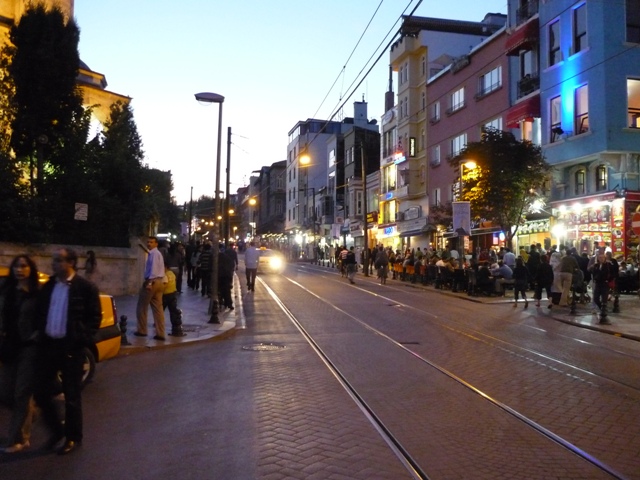
Cruising on the Boat on the Bosphorous River
Hagia Sophia From the Nearby Park

